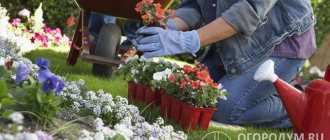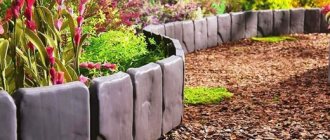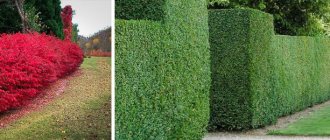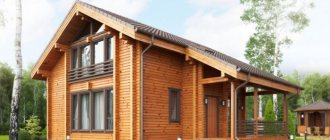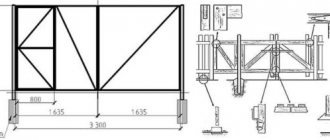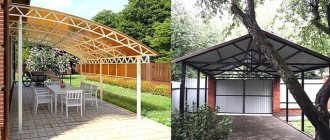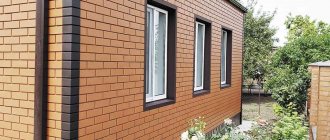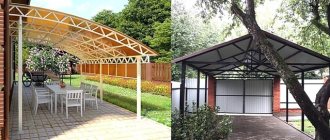The front garden is the calling card of a private home. The first impression of the owners among guests and just random passers-by depends on how well the space in front of the house is decorated. But fencing is not only a decorative element of the landscape, but also the main zoning tool. In addition, the fence protects the plantings from animals and serves as a basis for some creeping flowers. Knowing all this, it is important to choose the right material for the fence: whether it will be a wrought iron, wooden or plastic fence for the front garden.
Metal
Perhaps the most durable material for fencing. Any structure will serve you faithfully for several decades with proper care, be it a forged fence for the front garden or a solid one made of metal sheets. There are many advantages: they are durable, easy to maintain, reliable, durable.
This design can last up to 50 years if it is regularly coated with an anti-corrosion compound.
6 photos Instagram @centrzaborov.ru
Instagram @centrzaborov.ru
Unsplash
Instagram @zabor.152
Instagram @zabor.152
Instagram @zabor.152
Options for fences for the front garden
The essence of the front garden is to create a clear border of the flower bed. A small fence will do the job perfectly. It can be made from wood, metal or any other material. Before giving preference to one or another type of fencing material, you should first become familiar with its advantages, disadvantages and construction features. So, let's look at the most popular types of fencing for front gardens.
Decor in front of the house
Wooden fences
Wood fences are still very popular. Firstly, they look aesthetically attractive. Secondly, a picket fence is quite easy to erect. This option cannot be called the cheapest, but it is environmentally friendly.
This solution has the only drawback - fragility.
The photo shows a wooden picket fence.
Wooden picket fence for the front garden
Under the influence of unfavorable external factors, wood tends to deteriorate (rot). To prevent this, the lumber is pre-treated. Paint or varnish is ideal for these purposes. Such a fence will last as long as possible and will have an attractive appearance.
A beautiful fence for your front garden can be made in various designs:
- continuous canvas;
- with small holes between the wooden elements.
Installation of this fence is quite easy:
- Load-bearing pillars are dug in around the perimeter at a distance of no more than 3 meters.
- The dug pillars are connected to each other by horizontal logs.
- Picket fences are installed on horizontal logs using nails or self-tapping screws.
Front garden on the site
From a metal picket fence
Metal fences for your front garden have many advantages. The reasons for choosing an iron fence are:
- The fence gives a feeling of transparency and security at the same time.
- A variety of shapes, sizes and colors, thanks to which you can make your own flower garden unique.
- Fences and railings made of metal are much stronger than wood.
Combined
Often there are options made from a stone base with a metal top: they look very beautiful and are unlikely to be inferior in their characteristics to other barriers. Metal gives a certain lightness to the structure, and a stone base makes the fence more stable and durable. You can also add wooden parts here - trust your instincts and don’t be afraid to experiment.
Instagram @tanin_decor
Instagram @elitniezabory
Instagram @zabor.152
Instagram @zaboriya_ru
Instagram @svetlana_pakhorenko
Cost of ready-made structures for installation
The cost solely depends on the price of the material used and the size of the structure:
- wood can be ordered from 9 to 11 rubles. per piece (approximately per cubic meter - 3,300 rubles);
- a fence made of Euro picket fence will cost 45 rubles. per piece (picket length - 1500 mm, width - 125 mm);
- PVC fencing is offered at a price of 1800 rubles. per linear meter.
You can order material for arranging a front garden from various suppliers. It is worth noting that pricing policies may vary.
Metal front garden: pros and cons of use
A fence or fencing made of metal undoubtedly has excellent qualities that make them in demand. Among the advantages of arranging a metal front garden are the following:
- Ease of working with the material. Indeed, installation is so simple that you can do it yourself without any special skills.
- Cheapness of the finished product. To arrange a metal front garden, cheap material is used that will last quite a long time.
- Long service life. The strength of the metal allows you to use such a fence for decades without fear for the integrity and safety of the front garden or personal plot.
- Easy to repair and maintain. The main factor that is taken into account when using such a fence is corrosion. It appears over time on any metal products. If you fix it in time, then the risk of breaking the fence is minimal.
Of the shortcomings, only one is worth noting - the need to coat the fence with an anti-corrosion agent and paint it in a timely manner. Any scratches, frequent precipitation and sudden temperature changes cause the paint to peel off over time, making the metal more vulnerable to corrosion.
Return to contents
Plastic
The advantages of this choice are:
- cheapness;
- undemanding to care activities;
- does not rot, does not deteriorate under the influence of moisture.
However, it also has significant disadvantages:
- fragility - high probability of damage by children, wind, animals;
- tendency to burn out under the sun;
- low aesthetics, rather “cheap” appearance.
You can either purchase it ready-made or make it yourself from available materials, for example, bottles.
Simple metal After assembly, you need to paint it properly
Types of materials for fences
Before you start work, decide what size you want your fence to be. The height of the fence depends on what functions you plan to assign to it: to protect your flowers from uninvited animals, to provide support for climbing plants, to divide the territory, to make an accent as a decorative element. To some extent, this may also affect the choice of material for the fence.
The following factors will also help in choosing a material: service life, care, additional processing after time, price. Also, do not forget how important it is for an aesthetic appearance to keep all the buildings in the yard in the same style as possible. For example, if you live in a wooden house, then use this material for fencing; if your garden is decorated in Japanese style, then use stone for the fence; if there is a metal fence around the site, then the fence for the front garden should also be made of metal. In this case, the height of the fence should be directly proportional to the height and massiveness of the buildings in the yard.
A wrought iron fence should be in harmony with everything else
As for forged fences, they will not fit into every design, despite their ideological versatility. Forged elements look good next to antique-style houses. Experts also recommend repeating the same fragment in different elements of the exterior: on a lantern, on a gazebo and on a fence, for example.
Today there is a wide variety of materials for fences:
- A wooden fence is a classic. Building such a fence is not difficult or expensive;
- A wicker fence looks natural. Fruit branches or thin willow twigs are used;
- A stone fence is a reliable fence. Sandy, granite and slate rocks are suitable;
- Brick fence - any builder can handle it. Choose bricks of different colors and textures for the fence;
- A concrete fence is a durable material. There are ready-made individual concrete modules on sale with a variety of designs;
- A plastic fence is for those who like to store old things. Get design ideas from hand made websites;
- You can also combine materials - connect a stone foundation with a forged fence, or decorate a wooden fence with forged metal parts.
Any of the listed materials has certain advantages, but a metal front garden fence occupies a special place in this list. Forged fences are especially impressive with their variety of shapes, patterns and curls.
Ideas: which fence to choose (video)
Where is a picket fence used?
A picket fence most often encloses green spaces located near a house, using classic wooden slats decorated with traditional Russian ornaments. If we talk about the fence, then a metal picket fence is added to the wooden ones. It can be of different sizes, stand on a ledge or without it, have stone columns or be solid.
If the picket fence is located with small indentations from each other, it allows you to expose beautiful plantings in the form of bushes or flowers. Other design elements in the form of different colors of slats or their heights will look similar.
From wild stone
Stone is a natural material with an attractive appearance and texture, so it is perfect for construction. If you manage to assemble it yourself, the manufacturing cost will be cheaper. The stones can be placed in wire containers with a mesh structure or simply stacked on top of each other. It is characterized by very high durability and is also resistant to precipitation, wind and other weather conditions.
Combined
A combination of several types is possible, for example:
- stone and decorative elements made of wood;
- forged with a concrete base for stability;
- wood and metal.
Load-bearing elements must be well strengthened in the soil
DIY picket fence (step by step)
To achieve a conscientious result, we advise you to carefully plan everything, calculate the required amount of material and make sure that you have all the working tools: a screwdriver, a construction pencil or marker, a tape measure, self-tapping screws, a drill, a welding machine (if necessary), a long marking cord and stakes. From building materials for preparing the solution: cement, sand, crushed stone with water.
We assume that you have already purchased the picket fence, so the procedure will be as follows:
- Clear your area of debris and begin marking the area using rope and stakes according to your plan.
- Using a stretched cord, mark the expected location of the supports, the distance between which should not be less than three meters. If it is larger, the cross beams may not be able to cope with the weight of the slats and may burst. A smaller distance between columns is allowed. In this case, your fence will be even stronger.
- Using a shovel, dig holes for the supports, the depth of which should be approximately half the length of the picket fence. After that, layers of crushed stone and cement are poured into the pit.
- Using a level, insert the pillars and leave them for four days. After which you can begin installing the cross beams.
If the support post was made of metal, weld the corner first and install the boards on it. For wooden columns, you can get by with just self-tapping screws.
What's the result?
You can easily make a front garden near a house from corrugated sheets with your own hands, even without helpers. This type of fencing is durable and aesthetically pleasing. It will reliably protect the area in front of the house from the entry of strangers and stray animals. In addition, a front garden made of metal profiles is very easy to care for, and it costs less than most other options.
Useful article? Save it on social networks so you don’t lose the link!
Top ↑
Team oprofnastile.ru
Read on topic:
Installation of a fence made of corrugated sheets
Do you want to know how to properly install a fence from corrugated sheets? Then this article is for you. In it you will find comprehensive information about attaching corrugated sheets to the fence, about the construction of the foundation and other subtleties.
Choosing corrugated sheeting for a fence: overview of types and brands
If you don’t know which of the many types of corrugated sheeting is best suited for your fence, then this article is for you. Advantages and disadvantages of this or that type of profiled sheet, advice on selection in terms of price, reliability and design.
Euro picket fence for the front garden: which one to choose
There are several types of picket fence profiles: wide, narrow, semicircular, U-shaped, Austrian wicker. They differ both externally and in some functional characteristics, the main of which is the number of stiffeners. The more of them, the stronger and more reliable the picket fence. Of course, with regard to the fence for the front garden, the strength of the picket fence is not as important as for the main fence of the site. So when choosing a picket fence for a front garden, you can only take into account its external characteristics. As a rule, a picket fence for a front garden is installed with a polyester coating. This is a standard coating of good quality at an affordable price; we offer our customers more than 20 colors from this palette. Premium wood finish or powder painting will cost an order of magnitude more due to the better quality.
Euro picket fence from the Metal Roofing Center: some colors of standard polyester coating
What you should definitely pay attention to when choosing a picket fence for your front garden is the rolled edge. Rolling ensures the tightness of the product, which extends its service life. In addition, the processed edges of the picket fence protect against accidental cuts during installation and operation.
From timber
They have a thick section, so they are much less likely to be blown over by the wind. They look solid. Most often used when there is a need to hide plants from external influences - for example, from animals. Leaves room for creativity - for example, using wood carvings, modifying the shape of the tops of the boards (sharp, rounded), using rope as a tie.
Good wooden sample
Forged
Finely patterned forging
Unique Options: Wicker Fencing and Hedges
Owners of suburban areas strive to improve their properties in every possible way. Summer residents implement their own ideas in the design of their backyard areas and areas between the house and the road.
Among the most spectacular options for decorating a front garden, it is worth noting hedges created from ornamental plants. But when creating fences from plants, you need to consider a number of points:
- give preference to the most unpretentious vegetation that forms a voluminous crown;
- ensure optimal distance between green elements;
- irrigate and fertilize the hedge in a timely manner;
- trim bushes regularly.
Wicker fences look presentable and natural.
A great idea is to use willow branches or thin branches of fruit trees. But, of course, willow twigs have the greatest flexibility, so there will be no difficulties in using them. First, the twigs are softened in hot water to give them maximum flexibility. You just need to drive in support stakes and braid them with natural materials.
Read about how to arrange a beautiful pond at your dacha with your own hands: landscape ideas, photos with examples of ready-made ponds at your dacha.
How to make a swimming pool with your own hands? Read answers and construction tips here.
What is included in small architectural forms? Find out the answer in the article at:
Photo gallery
Look at the gallery of photographs of presentable front gardens with various types of fences. The photo shows options for fencing, vegetation and their combinations, allowing you to achieve a spectacular design of the area near the house.
Inexpensive fencing made of plastic or other materials can look very impressive if designed correctly. White fences are best suited for brightly flowering vegetation: they serve as an ideal backdrop for colorful colors.
When designing the area near a country house, pay special attention to the front garden. This area attracts the attention of passers-by and neighbors, so its decor should be especially presentable.
Remember that the fence located in the area between the house and the road has not only a protective function, but also a decorative one. There are many materials from which you can make a fence for your front garden; which one to choose is up to you.
Study the pros and cons of each option before making your final decision, making sure that the fence is in harmony with the overall design of the site and is not only beautiful, but also durable.
Installation of a picket fence
Despite the fact that doing this is easier than installing supports, we will tell you about the main nuances of the work stage:
First install the slats along each side of the columns using a level. If the wooden board is light and small in size, then you can get by with a couple of screws or nails at the top and bottom.
Next, stretch a thread between them, which will align all the other wooden planks. Secure a screw to each top of the previously installed slats and screw a fabric level onto them.
The wooden picket fence is almost ready and all that remains is to install the remaining slats. The easiest way to do this is to prepare a special block for the size of the indentation and use it instead of a ruler.
Once everything is ready, proceed to apply a protective solution to the wood and let it dry. Lastly, start painting. Remember that treated material lasts much longer. This procedure is recommended to be done once a year.
The advantage of wood is that you have the right to decorate the fence the way you want. Don't settle for the straight form. The simplest option is to make a wave, either concave or in the form of a hill. If you have a machine, you can decorate the slats with a pattern, or use screwdriver attachments to make a fancy ornament.
The price of a picket fence made of wood is much lower than that of its metal counterpart. But the advantage of the latter is the speed of assembly, as well as the absence of the need for care. Today, samples similar to wood of various species have appeared on the market. There is no need to paint or process metal, for fear of getting a splinter, and a special coating protects it from corrosion.
Recommendations from experienced builders
Advice from experienced builders will help you correctly install forged fences for your front garden:
- To protect the metal from rust as much as possible and prevent the paint from peeling, before painting the fence is first coated with an anti-corrosion compound.
- Don't skimp on quality paint. The service life of the metal structure and its aesthetic appearance depend on this.
- A foundation is only needed for heavy, high fencing. For a low fence, it is enough to concrete the posts in the ground.
Each element of the fence has an impressive mass. It is wise to carry out installation with an assistant.
Made of wood
Since it is accessible, modestly priced and has a natural appearance, such a fence for the front garden remains a classic choice. The advantages are:
- environmental friendliness and naturalness, safety for residents;
- ease of creation and installation;
- wide scope for the introduction of decorative elements;
- the ability to use paints of different compositions;
- low prices.
However, it must be taken into account that the material is highly susceptible to deterioration under the influence of biological (insects) and weather factors (precipitation, high humidity), so it will need to be treated with a special composition.
Woven from branches
On one side it complements the metal grille
An unusual DIY solution
A few words about the front garden
A front garden fence, like clothing for a person, can tell a lot about its owner. It not only protects our front garden from unwanted guests in the form of animals, but makes it possible to decorate our yard and make it unique!
Fencing also helps maintain order and can serve as a support for climbing plants and tall flowers.
When choosing a fence for the front garden, we certainly pay attention to what the main fence or fence is near our house. Of course, they do not have to be made of the same material, but their color and stylistic content should be harmonious.
The fence must fit into the overall design of the exterior
An important point is the climate zone where we live. If there is frequent precipitation and, in addition, serious temperature changes, we will try to use materials that are more wear-resistant and durable. The question arises: how to choose the source material we need? We will focus on several important factors:
- Aesthetic appearance.
- Lifetime.
- The need for maintenance of the structure.
- Speed and complexity of installation yourself.
- Cost (both with and without work).
Types of fences for the front garden and their features
Front garden fences are made from various materials. Popular fencing has visible advantages, but is not without its disadvantages. Therefore, it is worth evaluating each material carefully and studying the nuances of operation.
Hedge
Many people like this type of front garden fencing. To surround the garden they most often prefer:
- tall grasses with flowers;
- bushes separating the site from its neighbors;
- evergreen trees and shrubs.
Vegetation, depending on the variety, is planted in one or several rows. Hedges are used to delimit different zones of the site or instead of stone or wooden fences.
The benefits of a hedge:
- aesthetic appearance - a solid wall of plants perfectly complements the garden and landscape design;
- you can fence off the entire territory or small areas to create a secluded corner or hide part of the garden from prying eyes;
- poses a serious difficulty for thieves;
- plays a protective function - cuts snow, wind, dust, retains moisture and creates a good microclimate in the garden area;
- used in different stylistic solutions.
Disadvantages of a fence made from living plants:
- takes up more space than a regular fence for a front garden made of corrugated board or wood;
- painstaking care - watering, fertilizing, cutting;
- it takes years to grow a hedge, but a regular fence is built in a few days or weeks;
- mature plants are expensive;
- small areas look gloomy surrounded by high walls;
- looks gloomy in winter.
